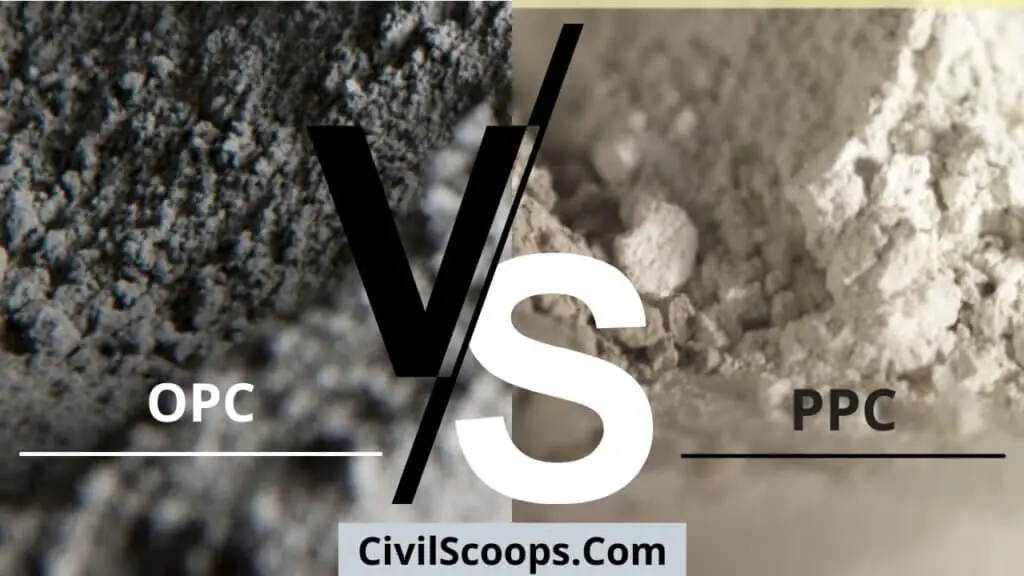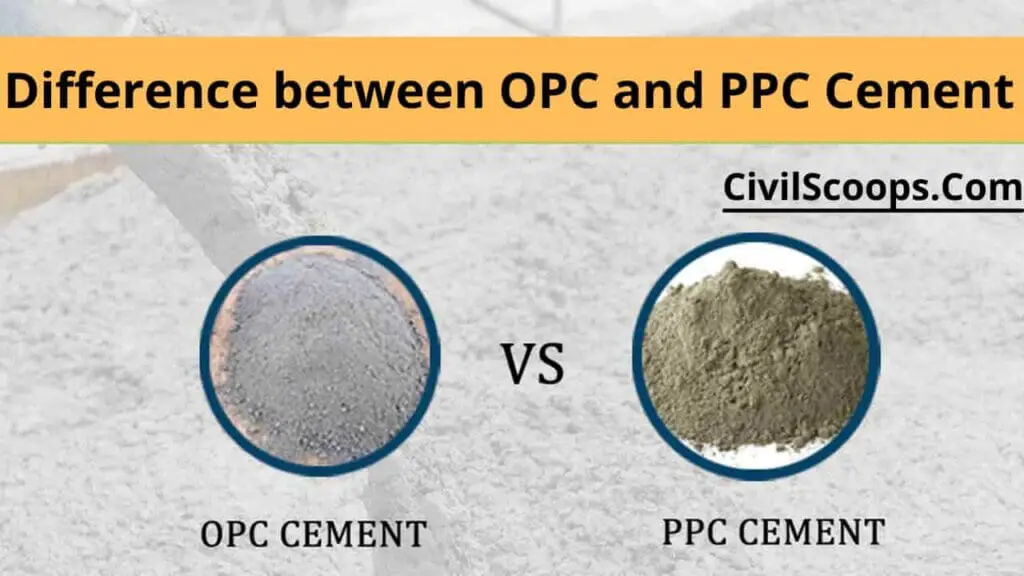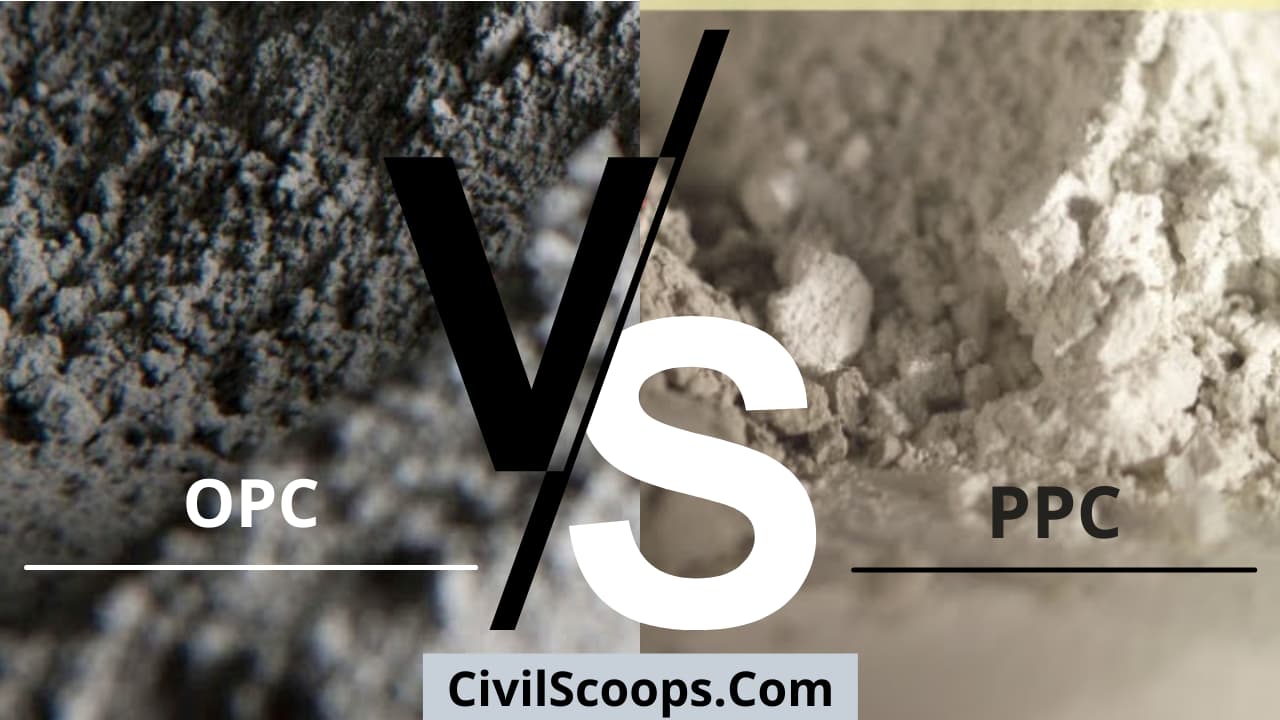OPC vs PPC | Difference between OPC and PPC Cement

Table of Contents
OPC vs PPC
Some Advantages that we get while using OPC in construction sites are.
- Ordinary Portland cement produces a highly durable and solid sound due to the very low percentage of alkali, chloride, magnesia, and free lime in its composition.
- In hostile environments there is almost negligible chloride that are present in Ordinary Portland cement content prevent corrosion of the concrete structure.
- Significant savings in cement consumption for concrete making of M15, M20, M25, M35, and pre-cast segments due to high strength of Ordinary Portland cement.
- Ordinary Portland cement 33-grade cement is IS: 269, for 43-grade cement, IS: 8112 is used and for 53 grade cement IS: 12269 is used.
- Ordinary Portland cement is made from limestone (CaCO3 & Clay) up to 1450oC in a kiln and with gypsum. Ordinary Portland cement uses limestone clay and gypsum which are natural stones and emits CO2 during making.
- Different grades available for Ordinary Portland cement are 33, 43, 53 grades.
- Ordinary Portland cement is costlier than Portland Pozzolana cement due to limestone.
- Ordinary Portland cement is less durable in aggressive weather and sulphate attack and therefore is not preferred for marine structures, hydraulic structures, sewage pipes, etc.
- Ordinary Portland cement has Low fineness and low permeability.
- Initial setting time of Ordinary Portland cement is 30 minutes.
- Final setting time of Ordinary Portland cement is 280 minutes. Ordinary Portland cement gains strength quickly so it results at a faster construction speed.
- The Ordinary Portland cement has a finiteness of 225 sq. m / kg. It has less lethargy than Portland Pozzolana cement. So, its high permeability results in low durability.
- Ordinary Portland cement contains active salt hence high heat hydration. The material is not mixed and gives 95% initial strength in 7 days.
- Shrinkage cracks will be more due to high heat of hydration for Ordinary Portland cement.
- Ordinary Portland cement is not preferred for large scale concrete.
Some Advantages that we get while using PPC in construction sites are.
- Portland Pozzolana Cement provides high durability of concrete structure due to low permeability of water.
- Portland Pozzolana Cement provides greater resistance to attack of alkalis, sulphates, chlorides, chemicals in hostile environment.
- Portland Pozzolana Cement has better work ability.
- Portland Pozzolana Cement has low heat of hydration.
- Due to high finiteness, Portland Pozzolana Cement has better cohesiveness with aggregates and creates more dense concreteness.
- The comparatively low water-cement ratio provides additional benefits to further increase the compressive strength of concrete in Portland Pozzolana Cement.
- Portland Pozzolana Cement has better surface finish.
- Portland Pozzolana Cement IS. 1489 (Part 1 & 2) 1991.
- Portland Pozzolana Cement is made up of Pozzolana materials such as fly ash, volcanic ash are blended to Ordinary Portland cement at a ratio of 15% to 35% by weight.
- Portland Pozzolana Cement consumes industrial waste like fly, ash, BF lava, etc. and is environmentally friendly.
- Portland Pozzolana Cement does not have any grade but attains a strength of 33-grade cement on the 228 days of curing achieves cement strength. After that its strength slows down.
- Portland Pozzolana Cement is cheap because limestone is replaced by Pozzolana.
- Portland Pozzolana Cement is highly resistant to sulphate and use and preferred for marine structures, hydraulic structures, sewage pipes, etc.
- Portland Pozzolana Cement has high fineness, high permeability and high durability.
- Initial setting time of Portland Pozzolana Cement is 30 Final setting time of Portland Pozzolana Cement is 600 minutes.
- Portland Pozzolana Cement gain strength over time.
- Portland Pozzolana Cement has finiteness of 300 sq. m / kg. It has more subtlety than Ordinary Portland cement. So, its high permeability results in low permeability.
- Portland Pozzolana Cement has materials like fly ash or slag, etc. This releases low heat of hydration. You get 75% strength in 7 days and 90% in 14 days.
- Portland Pozzolana Cement has low shrinkage crack.
- Portland Pozzolana Cement is preferred for mass concreting.
Difference between OPC and PPC Cement

The main differences between OPC and PPC are given below.
- Portland Pozzolana Cement (PPC) is a variant of Ordinary Portland cement (OPC). Pozzolana material i.e. fly ash, volcanic ash is added to the Ordinary Portland cement so that it becomes Portland Pozzolana Cement. Pozzolana content is added to cement at a ratio of 15% to 35% by weight.
- Both Ordinary Portland cement and Portland Pozzolana Cement are ecologically or eco friendly material but Portland Pozzolana cement uses natural and industrial wastes and thus reduce environmental pollution.
- Ordinary Portland cement is available in 3 different grades i.e. Grade 33, Grade 43 and Grade 53. Portland Pozzolana Cement is available in only one grade and its strength corresponds to the strength of grade 33 Ordinary Portland cement after curing.
- Ordinary Portland cement is the most commonly used cement in construction. Portland Pozzolana Cement is highly resistant to sulphate attacks, so its main use is in the construction of dams, foundations, seaside buildings or any buildings near sea shore, reservoirs, marine construction to name a few.
- Portland Pozzolana Cement is cheaper than Ordinary Portland cement.
- Portland Pozzolana Cement has lower initial setting strength than Ordinary Portland cement but hardens over a period of time with proper curing.
[su_box title=”FAQ” style=”default” box_color=”#333333″ title_color=”#FFFFFF” radius=”3″ class=”” id=””]
Plumbers Cement
After joining the pipes you must hold them together for 30 seconds until the plastic hardens or they can slip apart. It takes another 15 minutes for the joint to harden to a point at which it can withstand water pressure and two hours to fully cure.
Cornice Cement
Cornice cement is a setting type compound rather than a drying type that provides superior adhesion with good initial grab and high bond strength. Three different options are available in the cornice cement range, each with a defined setting time for varying job sizes: cornice cement 45 has a 45 minute working life.
Lafarge Ready Mix
Later that july, the new company was officially launched around the globe under the name of lafargeholcim, which later was renamed to holcim group in 2021. Although the merger was completed, the lafarge brand is retained within the group.
Martin Marietta Concrete
Anchoring the asset package are the lehigh cement redding and tehachapi, calif. Plants, with combined annual capacity upward of 1.6 million tons, plus seven terminals; 17 active crushed stone or sand & gravel sites; and, 29 ready mixed concrete plants.
Cement Driveway Contractors near Me
The minimum thickness in most codes for a residential driveway is 4-inches of concrete on a prepared base. Using stronger concrete can decrease that to 3” in some areas, although it won’t decrease the cost much if any. A properly prepared base and subbase will increase the driveway thickness by 4” to 8” too.
Parging Concrete
Parging is the coating applied to the visible (above-grade) portion of your home’s foundation walls. It is applied to both poured-concrete and concrete-block foundations to hide surface imperfections, marks from formwork and the like, so its role is essentially decorative.
[/su_box]
[su_note note_color=”#F2F2F2 ” text_color=”#333333″ radius=”3″ class=”” id=””]
Like this post? Share it with your friends!
Suggested Read –
- Types of Curing | Concrete Curing Time | How to Cure a New Concrete Slab | What Is Curing of Concrete | How Long Does Concrete Take to Dry | How Long Does It Take for Cement to Dry
- What Is Sheepsfoot Roller? | Characteristics of Sheepsfoot Rollers | Difference Between Padfoot and Sheepsfoot Rollers
- Monolithic Slab I Monolithic Definition I Monolithicfooting I Monolithic Slab Foundationl Monolithic Slab Foundation Design L What Is a Monolithic Slab L How to Form a Monolithic Slab
- What Is a Spillway | Types of Spillway | Definition Spillway | Spillway Design
- What Is Workability | What Is Workability of Concrete | Types of Workability of Concrete | Factors Affecting Workability of Concrete
[/su_note]
Originally posted 2024-04-05 05:14:01.

